Biology > QUESTIONS & ANSWERS > Chapter 16—EVIDENCE OF EVOLUTION. All Answers (All)
Chapter 16—EVIDENCE OF EVOLUTION. All Answers
Document Content and Description Below
Multiple Choice 1. Most scientists believe that the dinosaurs went extinct due to a. runaway global warming. b. competition from early mammals. c. a meteorite impact. d. a pandemic ... disease. e. unknown causes. : c POINTS: 1 REFERENCES: Section 16.9 Reflections of a distant past KEYWORDS: Bloom's: Understand NOTES: Modified 2. The K-Pg boundary layer is evidence of a. a crater. b. a meteorite impact. c. a period of planetary cooling. d. dinosaur life. e. sedimentary rock. : b POINTS: 1 REFERENCES: Section 16.9 Reflections of a distant past KEYWORDS: Bloom's: Understand NOTES: Modified 3. The bones labeled in Exhibit 16.4 are both a. results of the expression of the apetalal gene in an embryo. b. results of the expression of the antennapedia gene in an embryo. c. analogous structures. d. vestigial body parts. e. homologous structures. : d POINTS: 1 REFERENCES: Section 16.1 How did observations of nature change our thinking in the 19th century? KEYWORDS: Bloom's: Understand 4. The study of the patterns in the distribution of plants and animals around the world is a. diversity. b. biogeography. c. ecology. d. archaeology. e. environmentalism. : b POINTS: 1 REFERENCES: Section 16.1 How did observations of nature change our thinking in the 19th century? KEYWORDS: Bloom's: Remember 5. The study of body plans and structures among groups of organisms is called a. homologous structures. b. analogous structures. c. comparative morphology. d. morphological convergence. e. morphological divergence. : c POINTS: 1 REFERENCES: Section 16.1 How did observations of nature change our thinking in the 19th century? KEYWORDS: Bloom's: Remember 6. Fossils found in the lowest geological strata are generally the most a. advanced. b. complex. c. primitive. d. widespread. e. specialized. : c POINTS: 1 REFERENCES: Section 16.3 Why do biologists study rocks and fossils? KEYWORDS: Bloom's: Remember 7. During Darwin's voyage, he noticed that the finches had developed unique traits that suited them to their particular island habitat. Darwin's observations at this location greatly influenced his formation of his theory of natural selection: a. the Canary Islands. b. Africa. c. the Hawaiian Islands. d. the Galapagos Islands. e. Brazil. : d POINTS: 1 REFERENCES: Section 16.2 What is natural selection? KEYWORDS: Bloom's: Remember NOTES: New 8. Darwin was influenced by which concept attributable to Charles Lyell? a. The geological history of Earth is a series of catastrophes. b. Acquired characteristics can be inherited. c. Natural selection operates on the tremendous variation found in nature. d. All life forms a part of a great Chain of Being. e. Gradual geologic forces formed the earth's current landscape over a long period of time. : e POINTS: 1 REFERENCES: Section 16.2 What is natural selection? KEYWORDS: Bloom's: Remember NOTES: Modified 9. On his voyage, Darwin discovered fossils of the extinct armored glyptodonts and noticed the similarity they shared with modern: a. rodents. b. finches. c. turtles. d. armadillos. e. ostriches. : d POINTS: 1 REFERENCES: Section 16.2 What is natural selection? KEYWORDS: Bloom's: Remember NOTES: Modified 10. According to Darwin, natural selection is based on the ____ found in populations. a. acquired characters b. variations c. weakest members d. noncompetitors e. similarities : b POINTS: 1 REFERENCES: Section 16.2 What is natural selection? KEYWORDS: Bloom's: Remember 11. Thomas Malthus proposed that a. species gradually improved over generations because of an inherent drive toward perfection b. humans reproduce beyond the capacity of their environment to sustain them. c. the food supply and populations multiplied at the same rate. d. artificial selection was the key to evolution. e. natural selection was the key to evolution. : b POINTS: 1 REFERENCES: Section 16.2 What is natural selection? KEYWORDS: Bloom's: Remember NOTES: Modified 12. The person credited with being the codiscoverer of the theory of natural selection was a. Alfred Wallace. b. Charles Lyell. c. Thomas Malthus. d. James Hutton. e. John Henslow. : a POINTS: 1 REFERENCES: Section 16.2 What is natural selection? KEYWORDS: Bloom's: Remember Selecting the Exception 13. Four of the five s below are explanations of why the fossil record is incomplete. Select the exception. a. very few organisms were preserved as fossils. b. organisms tend to decay before becoming a fossil. c. animals with hard parts are preserved more easily. d. geological processes may destroy fossils. e. organisms that were widely distributed would lead to less fossils. : e POINTS: 1 REFERENCES: Section 16.3 Why do biologists study rocks and fossils? KEYWORDS: Bloom's: Remember OTHER: Select the exception NOTES: Modified 14. Four of the five s below are factors that contribute to strong fossil records of certain species. Select the exception. a. persisted for a long time b. hard body parts c. concentrated in one geological area d. lived in dense populations e. widespread distribution : c POINTS: 1 REFERENCES: Section 16.3 Why do biologists study rocks and fossils? KEYWORDS: Bloom's: Understand OTHER: Select the exception NOTES: New 15. Four of the five s below do not influence radioactive decay. Select the exception. a. temperature b. time c. pressure d. moisture e. chemical bonding state : b POINTS: 1 REFERENCES: Section 16.4 How is the age of rocks and fossils measured? KEYWORDS: Bloom's: Understand OTHER: Select the exception NOTES: New 16. Which organism would you expect to find preserved as a fossil? a. a jellyfish b. a shelled arthropod c. an earthworm d. a nematode e. a protistan such as an amoeba : b POINTS: 1 REFERENCES: Section 16.3 Why do biologists study rocks and fossils? KEYWORDS: Bloom's: Understand NOTES: Modified 17. Which habitat is most likely to be rich in fossils? a. eroding hillsides b. deserts c. polar ice caps d. bed of former shallow sea e. rocky plateau : d POINTS: 1 REFERENCES: Section 16.3 Why do biologists study rocks and fossils? KEYWORDS: Bloom's: Understand 18. Radiometric dating of the most ancient fossils uses the a. dating volcanic rocks above and below the fossil-containing layer of sedimentary rock. b. ratio of carbon 14 to carbon 12 in a sample of the fossil. c. counting of the rings of trees found with the fossils. d. comparison of unknown fossils with fossils of known age. e. transmission of radio waves through the fossil. : a POINTS: 1 REFERENCES: Section 16.4 How is the age of rocks and fossils measured? KEYWORDS: Bloom's: Remember NOTES: Modified 19. What percent of the 14C in a fossil still remains after three half-lives? a. 75 b. 50 c. 25 d. 12.5 e. 6.25 : d POINTS: 1 REFERENCES: Section 16.4 How is the age of rocks and fossils measured? KEYWORDS: Bloom's: Apply 20. Life probably originated during which geologic time? a. Archaean b. Cenozoic c. Mesozoic d. Carboniferous e. Pennsylvanian : a POINTS: 1 REFERENCES: Section 16.6 What is the geologic time scale? LEARNING OBJECTIVES: BCA.SES.11 Bloom's: knowled - Bloom's: knowledge KEYWORDS: Bloom's: Remember 21. We are currently in the a. Archaean eon. b. Proterozoic eon. c. Paleozoic era. d. Mesozoic era. e. Cenozoic era. : e POINTS: 1 REFERENCES: Section 16.6 What is the geologic time scale? KEYWORDS: Bloom's: Remember 22. During which epoch does a major extinction event begin? a. Eocene b. Oligocene c. Miocene d. Pleistocene e. Recent : e POINTS: 1 REFERENCES: Section 16.6 What is the geologic time scale? KEYWORDS: Bloom's: Remember 23. The large land mass that contained all the continents during the Triassic was called a. Laurasia. b. Pangea. c. Gondwana. d. Atlantis. e. Africa. : b POINTS: 1 REFERENCES: Section 16.5 How has earth changed over geologic time? KEYWORDS: Bloom's: Remember NOTES: Modified 24. Which term best describes the concept that molten rock emanates from the edge of a plate on the Earth’s crust, pushing rock on the other side into a trench? a. the theory of uniformity b. plate tectonics c. hot spots d. fault line rupture e. biogeography : b POINTS: 1 REFERENCES: Section 16.5 How has earth changed over geologic time? KEYWORDS: Bloom's: Understand 25. Which of the following serve as examples of morphological convergence? a. sharks, penguins, and porpoises b. panthers and tigers c. apes and monkeys d. sharks, skates, and rays e. mice, rats, and gerbils : a POINTS: 1 REFERENCES: Section 16.7 What evidence does evolution leave in body form? KEYWORDS: Bloom's: Apply 26. Possible evolutionary relationships, when determined solely by the study of comparative morphology, may be incorrect due to a. morphological divergence. b. morphological convergence. c. adaptive radiation. d. extinction. e. homology. : b POINTS: 1 REFERENCES: Section 16.7 What evidence does evolution leave in body form? KEYWORDS: Bloom's: Understand 27. The wings of a bird and the wings of a butterfly are ____ and show morphological ____. a. homologous; convergence b. analogous; convergence c. homologous; divergence d. analogous; divergence e. similar; evolution : b POINTS: 1 REFERENCES: Section 16.7 What evidence does evolution leave in body form? KEYWORDS: Bloom's: Understand 28. Which species would be considered more primitive based upon the structure of their limbs? a. bats b. stem reptiles c. porpoises d. penguins e. birds : b POINTS: 1 REFERENCES: Section 16.7 What evidence does evolution leave in body form? KEYWORDS: Bloom's: Understand 29. The three birds in Exhibit 16.2 look similar because of a. shared ancestry. b. morphological convergence. c. analogous structures. d. analogous structures and morphological convergence. e. shared ancestry and analogous structures. : a POINTS: 1 REFERENCES: Section 16.7 What evidence does evolution leave in body form? KEYWORDS: Bloom's: Apply 30. The study of early life stages has revealed the conservative nature of the genes responsible for a. food procurement. b. reproductive behavior. c. embryonic development. d. size. e. intelligence. : c POINTS: 1 REFERENCES: Section 16.8 How do similarities in DNA and protein reflect evolution? KEYWORDS: Bloom's: Understand 31. Through _____ , a body part of an ancestor is modified differently in different lines of descent. a. morphological divergence b. adaptive divergence c. morphological convergence d. homologous evolution e. natural selection : a POINTS: 1 REFERENCES: Section 16.7 What evidence does evolution leave in body form? KEYWORDS: Bloom's: Remember NOTES: Modified 32. Naturalists were puzzled when they started noticing patterns in morphology, including the presence of body parts with no apparent function. This and other observations made them question what traditional theory? a. evolution by natural selection b. environmental factors affect traits c. the great chain of being d. limited resources leads to competition e. survival of the fittest : c POINTS: 1 REFERENCES: Section 16.1 How did observations of nature change our thinking in the 19th century? KEYWORDS: Bloom's: Remember NOTES: New 33. A naturalist is studying morphological patterns that are shared between species in two temperate rainforests that are located on different continents. This would be an example of which field of study? a. biomorphology b. comparative ecology c. biological geology d. comparative geography e. biogeography : e POINTS: 1 REFERENCES: Section 16.1 How did observations of nature change our thinking in the 19th century? KEYWORDS: Bloom's: Apply NOTES: New 34. Which naturalist proposed that many species that once existed are now extinct? a. Cuvier b. Lamarck c. Darwin d. Malthus e. Wallace : a POINTS: 1 REFERENCES: Section 16.2 What is natural selection? KEYWORDS: Bloom's: Remember NOTES: New 35. What popular belief of the time did Lyell's theory of uniformity challenge? a. Fossils are not evidence of extinct species. b. The Earth is only 6,000 years old. c. The Earth does not change over time. d. Species do not change over time. e. All animals exists in perfect form. : b POINTS: 1 REFERENCES: Section 16.2 What is natural selection? KEYWORDS: Bloom's: Remember NOTES: New 36. In any population, some individuals have forms of traits that make them better suited to their environment than others. This is referred to as a(n) ______ trait. a. selective b. healthy c. advantaged d. adaptive e. competitive : d POINTS: 1 REFERENCES: Section 16.2 What is natural selection? KEYWORDS: Bloom's: Remember OTHER: New 37. Individuals that are better suited to their environment are likely to have more offspring and pass their genetic material on to future generations. This is referred to as: a. evolutionary success b. genetic strength c. fitness d. inheritance strength e. survival : c POINTS: 1 REFERENCES: Section 16.2 What is natural selection? KEYWORDS: Bloom's: Remember NOTES: New 38. Suppose that a dinosaur's body was not preserved in a way that produced a fossil; however, some of its footprints made during its life were preserved. These are considered what type of fossil? a. false b. impression c. indented d. trace e. print : d POINTS: 1 REFERENCES: Section 16.3 Why do biologists study rocks and fossils? KEYWORDS: Bloom's: Apply NOTES: New 39. Locations where molten rock rupture a tectonic plate are called: a. hot spots b. faults c. ridges d. weak spots e. trenches : a POINTS: 1 REFERENCES: Section 16.5 How has earth changed over geologic time? KEYWORDS: Bloom's: Remember NOTES: New 40. While related species do share similar genomes, it is the diversity in genes that makes them phenotypically different. How do most genes change and lead to species diversity? a. deletions b. additions c. translocations d. any type of mutation e. substitutions : d POINTS: 1 REFERENCES: Section 16.8 How do similarities in DNA and protein reflect evolution? KEYWORDS: Bloom's: Understand NOTES: New Matching the question(s) with one of the geologic times listed below: a. Carboniferous b. Cretaceous c. Ordovician d. Pleistocene e. Triassic REFERENCES: Section 16.6 What is the geologic time scale? KEYWORDS: Bloom's: Remember OTHER: Classification Questions 41. first land plants appear : c POINTS: 1 42. high O2 levels allow giant arthropods : a POINTS: 1 43. modern humans appear : d POINTS: 1 44. extinction event at end led to demise of dinosaurs : b POINTS: 1 45. dinosaurs and turtles first appear : d POINTS: 1 46. flowering plants originate : b POINTS: 1 47. mammals first appear : e POINTS: 1 The age of fossils can be determined by radiometric dating. Match the following terms with the best descriptions. a. 12C b. 14C c. 5730 years d. 14C to 12C ratio e. half-life f. decay REFERENCES: Section 16.4 How is the age of rocks and fossils measured? KEYWORDS: Bloom's: Remember NOTES: New 48. This isotope remains stable. : a POINTS: 1 49. This is the time it takes for half of a quantity of a radioisotope to decay. : e POINTS: 1 50. This isotype decays. : b POINTS: 1 51. A decaying isotype becomes this form of carbon. : a POINTS: 1 52. This is the specific half life of a carbon isotype. : c POINTS: 1 53. Atoms of a radioisotope become atoms of other elements as their nucleus disintegrates. : f POINTS: 1 54. This can be measured to determine the age of a fossil. : d POINTS: 1 Match the description with the correct term: a. fault b. trench c. ridge d. hot spot e. plate tectonics REFERENCES: Section 16.5 How has earth changed over geologic time? KEYWORDS: Bloom's: Apply NOTES: New 55. Where the advancing edge of one plate plows under an adjacent plate and buckles it. : b POINTS: 1 56. Molten rock wells up from Earth’s interior and pushes tectonic plates. : c POINTS: 1 57. Ruptures in Earth’s crust where plates meet. 58. Where molten rock ruptures a tectonic plate. 59. Theory that Earth’s outer layer of rock is cracked into plates, that slowly move over time. : e POINTS: 1 Subjective Short 60. What is meant by natural selection? 61. How does carbon-14 dating work? 62. Zircon crystals form from volcanic rock. The age of zircon crystals can be precisely measured. What exactly is measured in zircon crystals? 63. Why are the master genes of embryonic development so highly conserved? 64. What can be deduced about dinosaur extinction from the K-Pg boundary sequence? 65. Why is it more likely that coincidental homologies (i.e., similarities that are just by chance) are statistically more likely to occur with DNA than protein comparisons between species? Essay 66. If you think of geologic time spans as minutes, life’s history might be plotted on a clock such as the one in Exhibit 1. According to this clock, the most recent epoch started in the last 0.1 second before noon. Where does that put you? 67. Describe how scientists use fossil finds and radiometric dating to piece together evolutionary history. Why is this useful when scientists discover a missing link fossil? 68. For natural selection to occur, adaptive traits must be inheritable. This means that change occurs at the level of DNA. the following question with this in mind. a. How do new traits develop? b. How may the genetic changes contribute to evolution by natural selection? c. How can the degree of similarity in DNA or protein sequence be used to infer the degree of relatedness between species? [Show More]
Last updated: 1 year ago
Preview 1 out of 18 pages
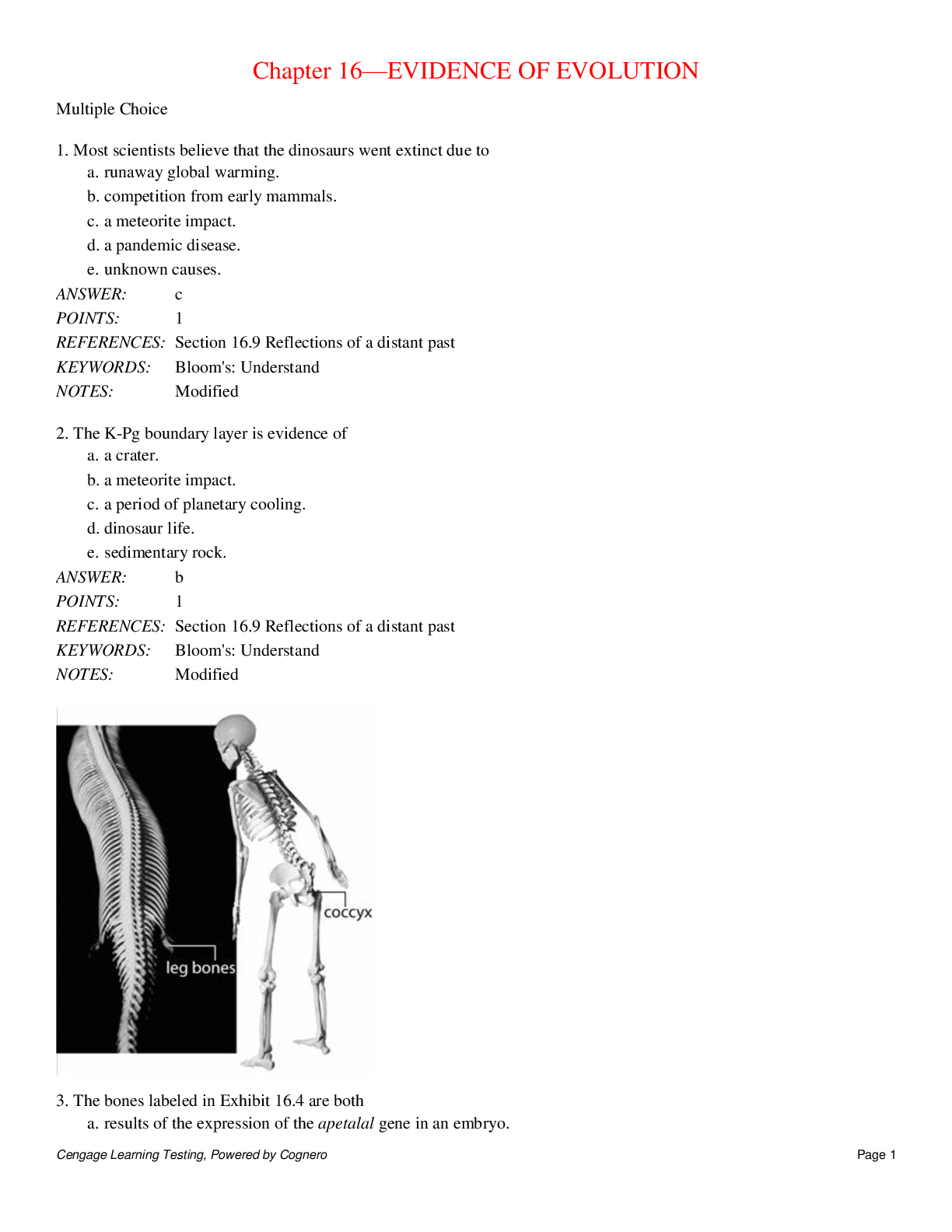
Reviews( 0 )
Document information
Connected school, study & course
About the document
Uploaded On
Nov 27, 2019
Number of pages
18
Written in
Additional information
This document has been written for:
Uploaded
Nov 27, 2019
Downloads
0
Views
80







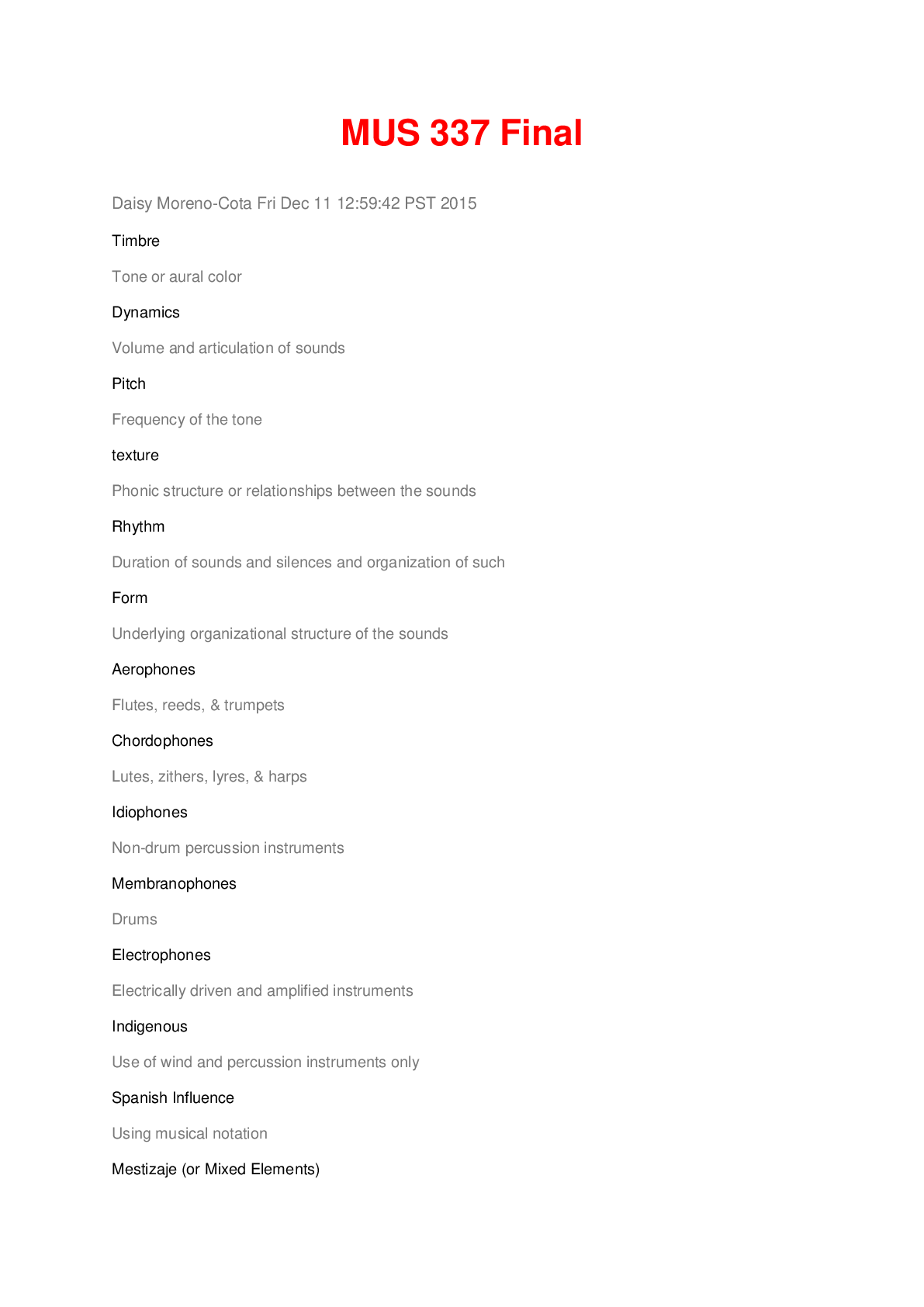




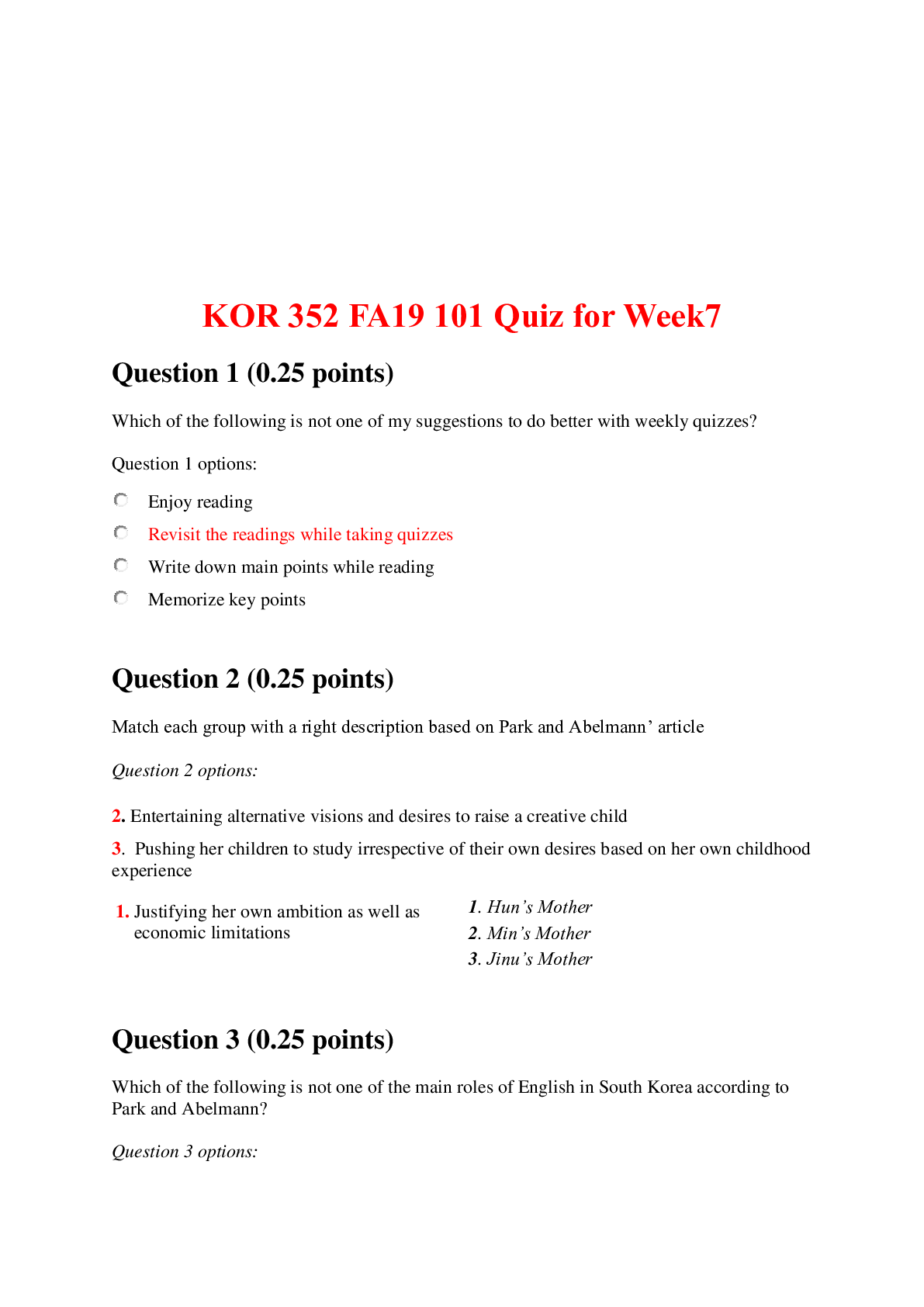


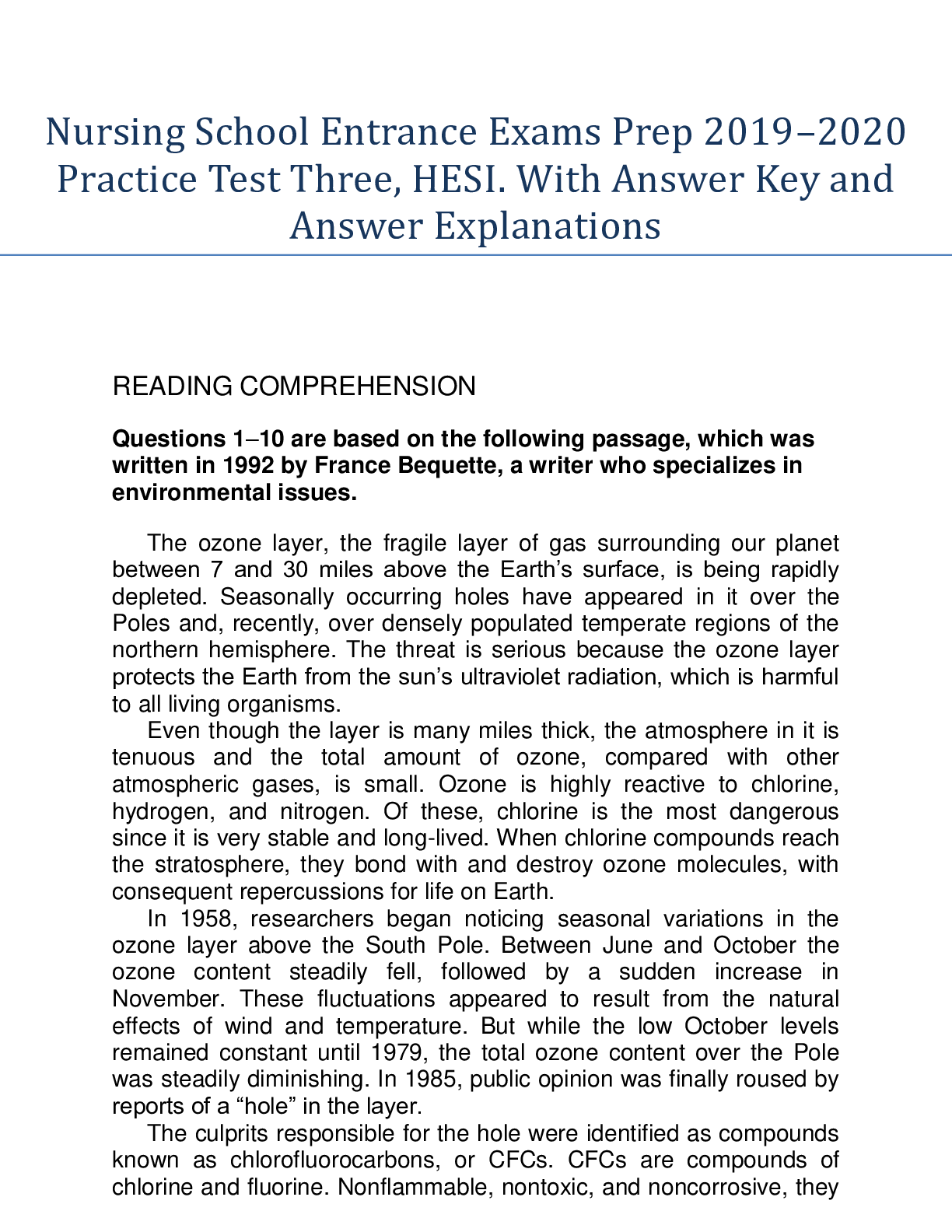

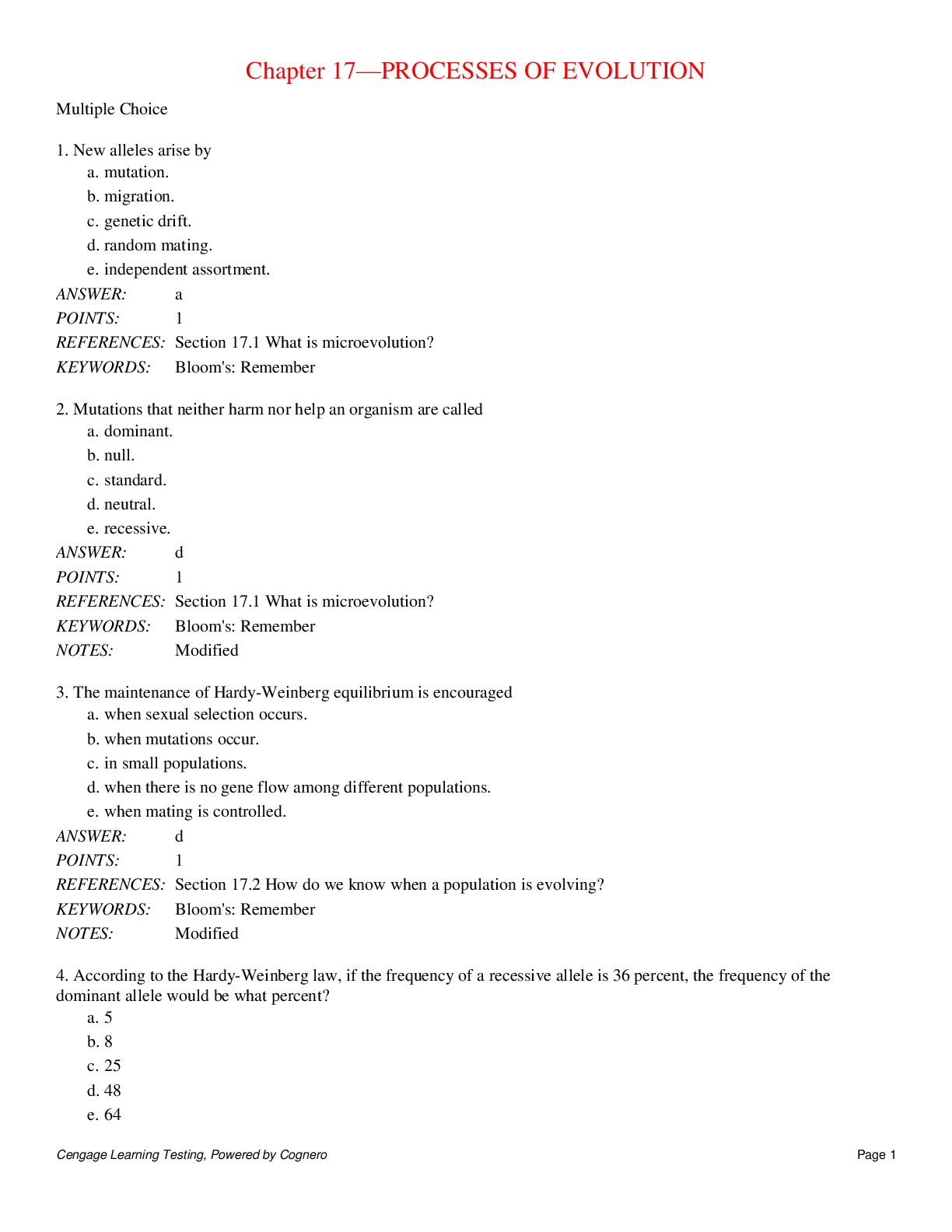


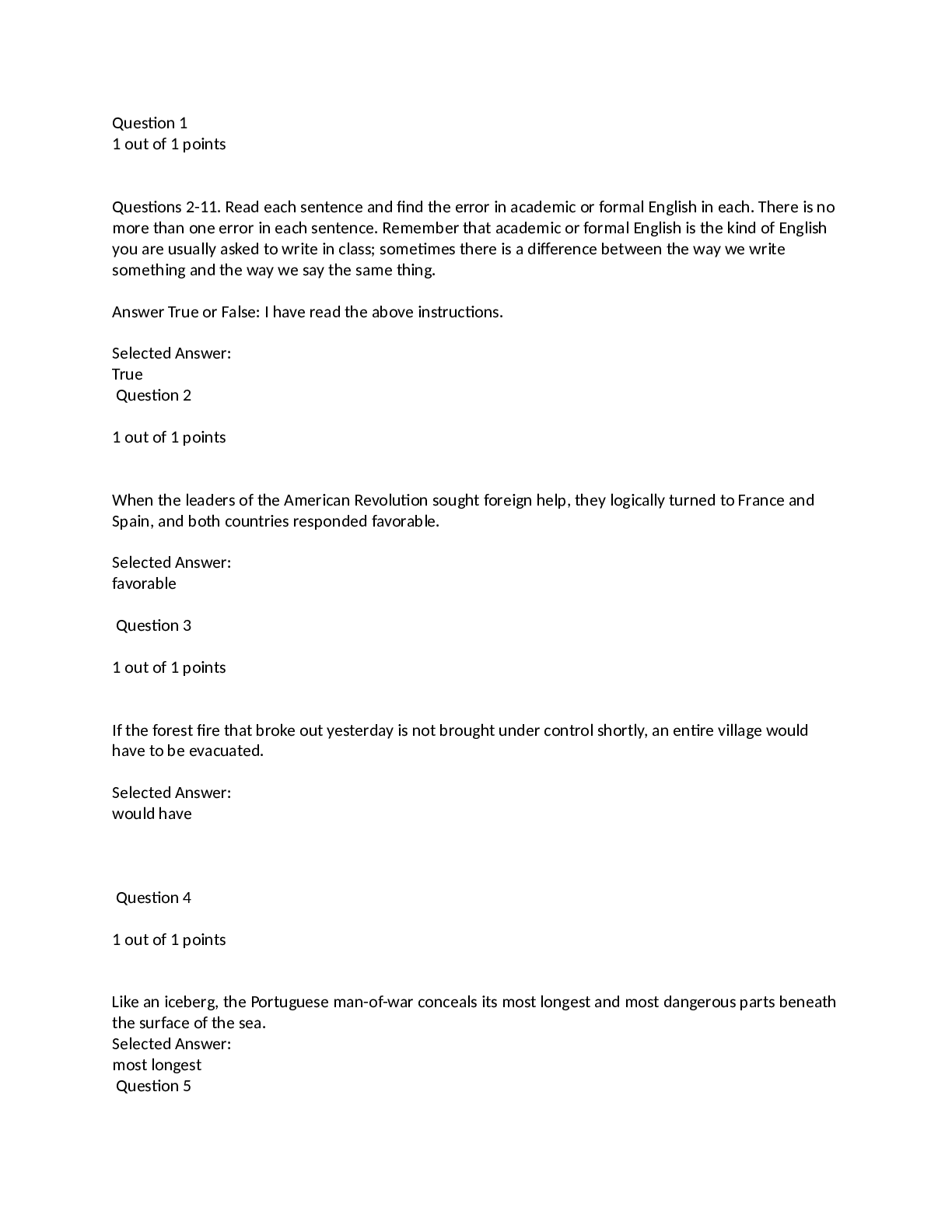
.png)
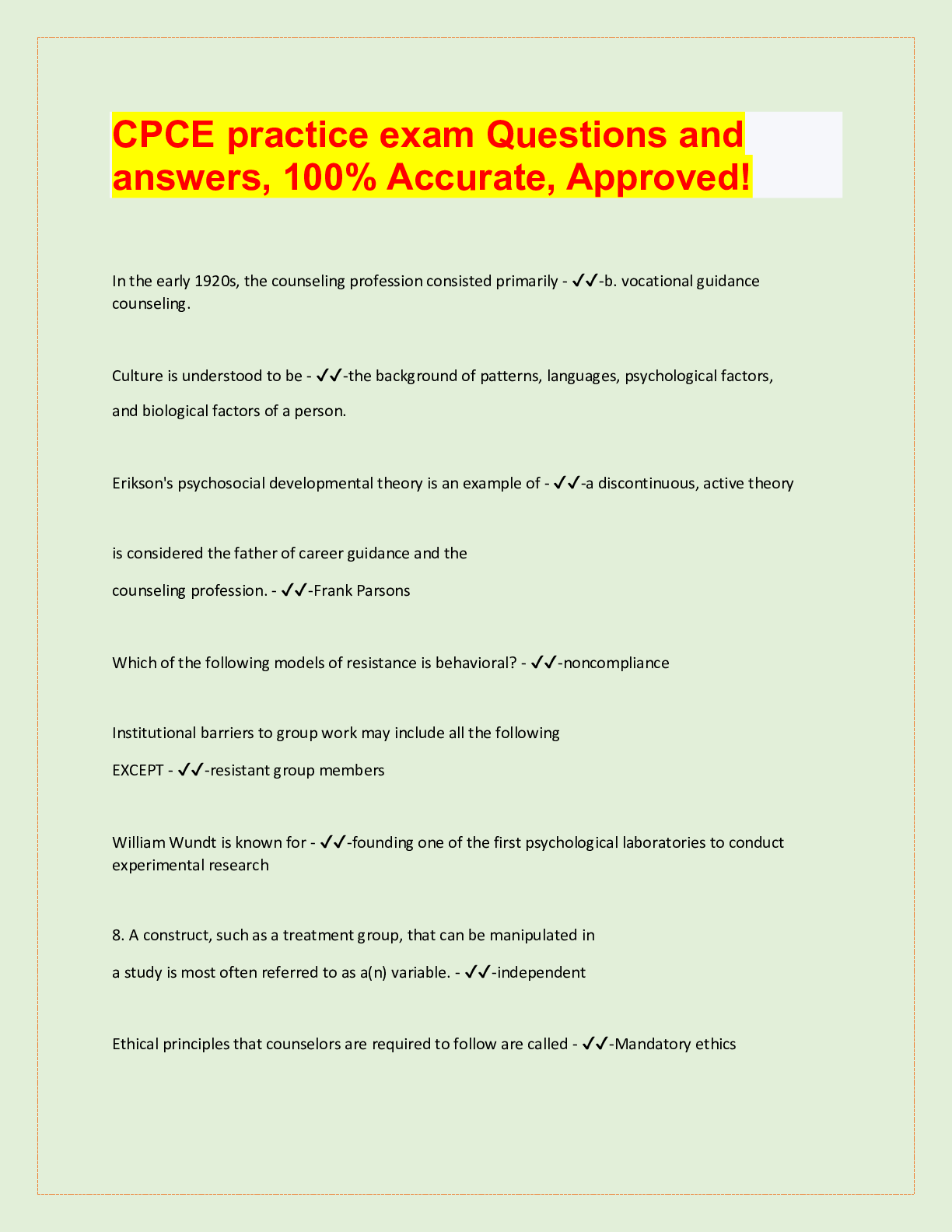

.png)


.png)


.png)

.png)
.png)
.png)

